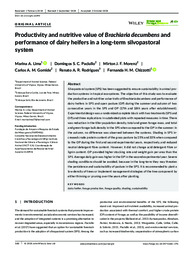Productivity and nutritive value of Brachiaria decumbens and performance of dairy heifers in a long-term silvopastoral system.
Productivity and nutritive value of Brachiaria decumbens and performance of dairy heifers in a long-term silvopastoral system.
Autoria: LIMA, M. A.; PACIULLO, D. S. C.; MORENZ, M. J. F.; GOMIDE, C. A. de M.; RODRIGUES, R. de A. R.; CHIZZOTTI, F. H. M.
Resumo: Silvopastoral system (SPS) has been suggested to ensure sustainability in animal production systems in tropical ecosystems. The objective of this study was to evaluate the productive and nutritive value traits of Brachiaria decumbens and performance of dairy heifers in SPS and open pasture (OP) during the summer and autumn of two consecutive years in the SPS and OP (17th and 18th years after establishment). Experimental design was a randomized complete block with two treatments (SPS and OP) and three replications in subdivided plots with repeated measures in time. There was reduction in the tiller population density, total and green forage mass, and total and green forage bulk density in the SPS when compared to the OP in the summer. In the autumn, no difference was observed between the systems. Shading in SPS increased crude protein content of the grass pasture by 25% and 33% when compared to the OP during the first and second experimental years, respectively, and reduced neutral detergent fibre content. However, it did not change acid detergent fibre or lignin content. OP provided higher stocking rate and weight gain per area than the SPS. Average daily gain was higher in the OP in the second experimental year. Severe shading conditions should be avoided, because in the long-term they may threaten the persistence and sustainability of pasture in the SPS. It is recommended to plant a low density of trees or implement management strategies of the tree component by either thinning or pruning over the years after planting.
Ano de publicação: 2019
Tipo de publicação: Artigo de periódico
Unidade: Embrapa Gado de Leite
Palavras-chave: Brachiaria Decumbens, Dairy heifers, Forage production, Forage quality, Forragem, Produção, Qualidade
Observações
1 - Por padrão são exibidas publicações dos últimos 20 anos. Para encontrar publicações mais antigas, configure o filtro ano de publicação, colocando o ano a partir do qual você deseja encontrar publicações. O filtro está na coluna da esquerda na busca acima.
2 - Para ler algumas publicações da Embrapa (apenas as que estão em formato ePub), é necessário ter, no celular ou computador, um desses softwares gratuitos. Sistemas Android: Google Play Livros; IOS: iBooks; Windows e Linux: software Calibre.
Acesse outras publicações
Acesse a Base de Dados da Pesquisa Agropecuária (BDPA) para consultar o acervo completo das bibliotecas da Embrapa.

